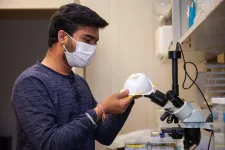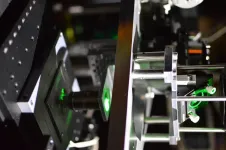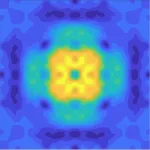(Press-News.org) Even the best face masks work only as well as their fit.
And poorly fitting face masks greatly increase the risk of infection from airborne pathogens compared to custom-fitted masks, according to a new study by the University of Cincinnati.
Researchers in UC's College of Engineering and Applied Science used computerized tomography or CT scans of three different-sized face masks attached to three different-sized dummy heads to measure the gaps between the face and the fabric. Then they calculated the leaks from these gaps to determine the infection risk.
They found that while N95 masks are effective barriers against airborne diseases like COVID-19, poorly fitting masks can have substantial leaks around the face that reduce their effectiveness and increase the risk of infection.
"Many people do not realize that the fit of face masks can vary. There are different face shapes and different sizes of masks," said Rupak Banerjee, a professor in UC's Department of Mechanical and Materials Engineering.
"If you do not match them well, you can lead to greater leaks and higher risks of infection," he said.
The study was published in the Nature journal Scientific Reports.
Banerjee collaborated on the study with his former students, including UC graduates Prasanna Hariharan, Neha Sharma and Gavin D'Souza. Hariharan, the study's lead author, works for the U.S. Food and Drug Administration's Division of Applied Mechanics.
UC's use of CT scans improved the accuracy of contact modeling from previous studies that relied on gap geometry and computational models for estimates.
UC used three different sized N95 face masks from the National Institute for Occupational Safety and Health along with three standard mannequin heads identified as small, medium and large. From the CT scans, they could create a 3D computer-aided design model that showed the gaps between the masks and the face on each subject.
They calculated the airflow rates through the gaps to identify the relative infection risk for each mask on each face.
The aerosol transport attributed to leaking out the sides of the masks varied from as little as 30% to as much as 95% for the worst-fitting masks. Researchers found the leaks were most likely around the nose. Interestingly, they noticed that the gaps were often asymmetrical on the symmetrical dummy faces.
Researchers found that poorly fitted face masks can as much as double the infection risk to the wearers and people around them.
"A lot of people don't wear masks properly. They keep the nose exposed, which isn't helpful," Banerjee said.
But understanding that masks can often leak around the nose could help people pay more attention to the fit when buying and wearing masks.
Editor of the American Society of Mechanical Engineering Journal of Medical Devices, Banerjee said innovations in infection control have been hot topics this year.
"We are going to have a special issue soon about pandemic-response medical devices, including face masks and face shields," he said.
Meanwhile, UC's research could educate consumers and help manufacturers design better-fitting masks, he said.
While many countries are relaxing social-distancing mandates, Banerjee said he isn't putting his face masks away just yet.
"I'll continue to wear a face mask because of the risk from the COVID-19 variants," he said. "We're still not sure how effective the vaccine is on the variants. So it's a good idea to continue wearing masks in gatherings for now."
INFORMATION:
Scientists have developed polypeptide-based materials that act as effective vectors for delivering gene therapies. The first-of-its-kind platform enables the vectors to be adapted to suit the specific gene therapy cargo.
The work, led by researchers from RCSI University of Medicine and Health Sciences and funded by Science Foundation Ireland, is published in Biomaterials Science.
A major challenge for gene therapies is preparing them in a way that can deliver the genetic information into the host cells. For the Covid-19 vaccines that use mRNA technology, the genetic information is delivered ...
DARIEN, IL - A study of nearly 2,500 adults found that having trouble falling asleep, as compared to other patterns of insomnia, was the main insomnia symptom that predicted cognitive impairment 14 years later.
Results show that having trouble falling asleep in 2002 was associated with cognitive impairment in 2016. Specifically, more frequent trouble falling asleep predicted poorer episodic memory, executive function, language, processing speed, and visuospatial performance. Further analysis found that associations between sleep initiation and later cognition were partially explained by both depressive symptoms and vascular ...
DARIEN, IL - A 15-year longitudinal study shows that childhood insomnia symptoms that persist into adulthood are strong determinants of mood and anxiety disorders in young adults.
Results show that insomnia symptoms persisting from childhood through adolescence and into adulthood were associated with a 2.8-fold increased risk of internalizing disorders. Insomnia symptoms that newly developed over the course of the study were associated with a 1.9-fold increased risk of internalizing disorders. No increased risk of internalizing disorders was found for those children in whom insomnia symptoms remitted during the study period.
"We found that about ...
MELVILLE, N.Y., June 9, 2021 -- The world is filled with myriad sounds that can overwhelm a person with relentless acoustics. Noise is so prevalent in everyday life that the concept and achievement of comfortable quiet is hard to define.
During the 180th Meeting of the Acoustical Society of America, which will be held virtually June 8-10, Aggelos Tsaligopoulos, from the University of the Aegean, will describe how quiet could be measured in the hopes of better understanding its impact on people. The session, "Towards a new understanding of the concept of quietness," will take place Wednesday, ...
In a major scientific leap, University of Queensland researchers have created a quantum microscope that can reveal biological structures that would otherwise be impossible to see.
This paves the way for applications in biotechnology, and could extend far beyond this into areas ranging from navigation to medical imaging.
The microscope is powered by the science of quantum entanglement, an effect Einstein described as "spooky interactions at a distance".
Professor Warwick Bowen, from UQ's Quantum Optics Lab and the ARC Centre of Excellence for Engineered Quantum Systems (EQUS), said it was the first entanglement-based sensor with performance beyond the best possible existing technology.
"This breakthrough will spark all sorts of new technologies - from better navigation ...
While the IPCC is in the midst of the drafting cycle of the Sixth Assessment Report, whose publication will start in the second half of 2021 - one of the most relevant events for the global climate change community, there is an ongoing debate on how to assess the feasibility of ambitious climate mitigation scenarios developed through integrated assessment models and to what extent they are actually achievable in the real world. In their new study published in Environmental Research Letters, researchers from the RFF-CMCC European Institute on Economics and the Environment (EIEE) and IIASA developed a systematic ...
What The Study Did: An observational study of more than 27,000 veterans who received a positive test result for COVID-19 reports that risk factors such as housing problems, financial hardship, alcohol use, tobacco use and substance use weren't associated with higher mortality.
Authors: J. Daniel Kelly, M.D., M.P.H., of the University of California, San Francisco, is the corresponding author.
To access the embargoed study: Visit our For The Media website at this link https://media.jamanetwork.com/
(doi:10.1001/jamanetworkopen.2021.13031)
Editor's Note: The article includes funding/support disclosures. Please ...
What The Study Did: This study looked at whether there was an association between rideshare use, motor vehicle crash traumas and impaired driving convictions in Houston, Texas, by comparing traumas and convictions before and after the introduction of Uber.
Authors: Christopher R. Conner, M.D., Ph.D., of the McGovern Medical School at the University of Texas Health Science Center at Houston, is the corresponding author.
To access the embargoed study: Visit our For The Media website at this link https://media.jamanetwork.com/
(doi:10.1001/jamasurg.2021.2227)
Editor's Note: The article includes funding/support disclosures. Please see the article for additional information, including other authors, ...
A condition that affects the blood, known as idiopathic thrombocytopenic purpura (ITP), may be associated the Oxford-AstraZeneca vaccine in rare cases, research suggests.
The very small increased risk of the condition - which is characterised by low platelet counts - is estimated to be 11 per million doses, similar to figures seen in vaccines for flu and MMR.
A low number of platelets - blood cells that help prevent blood loss when vessels are damaged - can result in no symptoms or can lead to an increased risk of bleeding or, in some cases, clotting.
Researchers say that the increased chance of developing ITP after receiving the vaccine remains smaller than the risk of developing it because of Covid-19 and should ...
Batteries have come a long way since Volta first stacked copper and zinc discs together 200 years ago. While the technology has continued to evolve from lead-acid to lithium-ion, many challenges still exist--like achieving higher density and suppressing dendrite growth. Experts are racing to address the growing, global need for energy-efficient and safe batteries.
The electrification of heavy-duty vehicles and aircraft requires batteries with more energy density. A team of researchers believes a paradigm shift is necessary to make a significant impact in battery technology for these industries. ...




